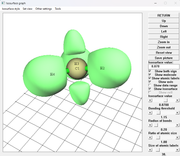I have just succesfully ploted ELF-alpha of CH3 radical:
 ]]>
]]>What I meant is to plot ELF-alpha and ELF-beta as in the following paper:
https://onlinelibrary.wiley.com/doi/ful … /qua.10515
It should be interesting to plot ELF-alpha since ELF does not show a basin for an unpaired electron as in CH3 radical
]]>For example, to calculate ELF-beta, first go to subfunction 26 of main function 6, set occupation number of all alpha orbitals to 0, then perform ELF calculation as usually, you will obtain what you need. Note that after loading input file for an open-shell system, Multiwfn directly shows the range of alpha and beta orbitals on screen.]]>
Thanks in advance]]>